[Jimbaux just needed . . . to realign.]
Repatriated
Hello. After an intensely memorable last day in Mexico in which I left Monterrey, drove on a two-lane state highway to the border, got pictures of trains, and crossed into the USA well after dark, a new day dawned, and it was time to trek across southern Texas and much of southern Louisiana to go home. Compared to what preceded it, this article is anti-climactic, but it is the closure of this 2004 Mexico series.
Surely, I was tired from a long and intense day after a memorable last night in Monterrey, but I still would have wanted to take advantage of the opportunity and get some good early morning shots in and around Laredo. Apparently, though, I did not, as my first picture was not taken until right about the time that the good lighting was burning away.
UP
I do not remember why, but my first picture on this morning was not until after 09:30 when I shot this quartet of Union Pacific locomotives.
Perhaps I just slept late. That is probably what happened. I have difficulty imagining that I was out looking for things to photograph in the early-morning light in Laredo and did not find anything.
Ensuring that every article in this 2004 Mexico series has a picture of Mexico in it even if all of the pictures in the first and last articles are taken in the United States, here we are at the international bridge a few minutes later with another quarter of UP locomotives on a northbound train.
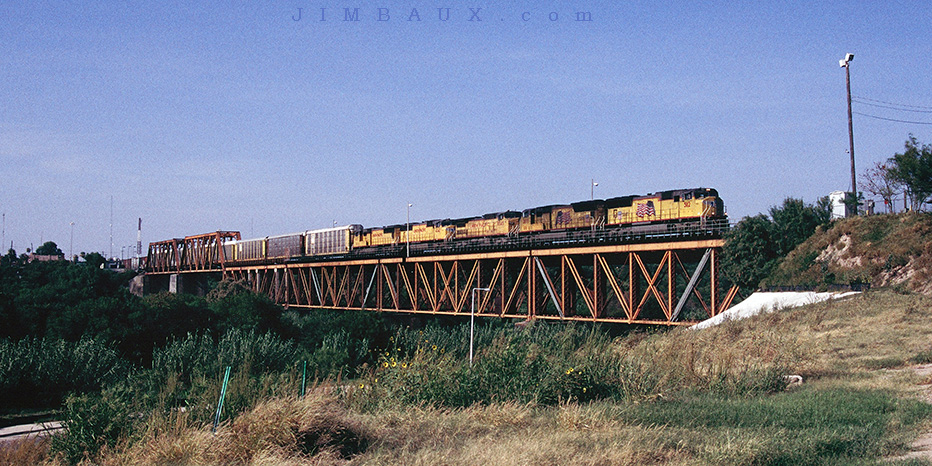
Yes, like you saw on May 31, the entire superstructure of the bridge is in Mexico, specifically in the city of Nuevo Laredo in the state of Tamaulipas.
So Long, Laredo
I apparently left town shortly after taking this picture, truly putting Mexico in my rearview mirror. I have almost no memory of this particular day, and nearly all of the information that I have about that day is in the form of these photographs and the information in the picture log book.
Had I been shooting digital at the time, I’d likely have many more pictures, especially or relatively simple stuff. The sad thing is that neither on the way coming on May 31 nor on the way going home today did I get any shots on the Texas-Mexican Railway; I didn’t see any trains on the line either!
As I said last night, now that I was back in the United States, I was looking at things differently, and this would be especially true once I really arrived back home in southeastern Louisiana. Some of that is too deep to discuss, but I would like to discuss one very concrete example, something of which I still think on every day in which I drive an automobile and that I need to work harder to change.
We Need Flashing Green Traffic Lights In The USA
Once I returned to the United States, I noticed that I would get frustrated when traffic lights that were green would suddenly turn yellow without any warning, giving me very little warning before they would turn red and I would be required to stop, and frustrating me that I had wasted the effort and the gasoline to drive at whatever speed I was driving – you know, 55mph speed limit in some places that have traffic lights – only to have to hurriedly stop, which is unnecessarily dangerous. That frustration continues to this day. It is not right that we are not given more warning that we will not make it through a traffic light; it causes us to waste fuel, waste brake pads, and the rapid deceleration – which makes rapid acceleration on the other end more likely – is unnecessarily dangerous, thereby making driving more difficult and intense than it needs to be.
If you have never driven an automobile outside of the United States and never been on a Mexican road, you probably don’t know what I mean; you can’t see the problem that I so clearly see. I don’t know if the devices are universal throughout Mexico, but it at least plenty of Monterrey, traffic lights have a flashing green light before a green light turns yellow. This is an additional warning that a red light is approaching. The green light flashes for about the same amount of time that the yellow light is on at all, meaning that motorists have a warning that is about twice the amount of time that Americans have for traffic lights with roads of the same speed limit. One person told me that he thinks (but says that he does not really know) that the flashing green light exists to help pedestrians be better warned that they don’t have time to cross the street. That may be true, even though in the USA we have special signs – often flashing! – for pedestrians, but it seems to be irrelevant, as I am describing the positive effect of the flashing green, regardless of the original intention.
In Monterrey, when I was hundreds of feet from the traffic light, the flashing green light let me know that I was not going to make that light (twice as early as the yellow light did), meaning that I can take my foot off the accelerator and even possibly lightly brake to come to a gentle stop – or perhaps no stop at all if the red light is short.
Such is not the case in the USA, and this needs to change; we would save money and be safer. When you can see a traffic light a quarter-mile away, it makes no since to haul ass at 55mph toward it for most of that distance only to suddenly, only 100′ from the light, pull your foot off of the accelerator and immediately apply the brake. This practice is as wasteful as it is dangerous. If you had known that you were not going to make that light, you could have taken your foot off of the accelerator, used less fuel, and worn down your brake pads a little bit less; you also would have been less likely to get in a wreck, since instances of acceleration and deceleration – especially around traffic lights – are a major cause of wrecks, and the greater the acceleration or deceleration, the more likely the wreck is to take place, and the more severe it might be.
The technology obviously exist. Mexico has it. Why should we not use it ourselves? Many people accelerate when they see yellow lights, and that mainly is because they are so close to the light and already moving at full speed that they feel, understandably, that it is wasteful and dangerous to suddenly stop. It also causes needless acceleration, since the flashing green light would sometimes, depending on how far you are from the light and how many automobiles are between you and the light, mean that you would not need to stop at all for a red light; you’d be able to start accelerating again at about 15-20mph once the light turned green again, which requires far less fuel than starting from zero. Acceleration requires plenty of energy; this is why your RPM meter jumps high when you are moving from a dead stop and goes back down once you reach a consistent speed.
I am very good at seeing ideas and problems that other people do not see (which is why I am a philosopher and an artist), but I am not at all good at organization or activism. (Being an introvert makes me really good at some things and really bad at other things.) If anyone could offer advice about how I could go about effectively working toward having all traffic lights in the USA have flashing green lights, I would appreciate it. Yes, I realize that not every motorist would take advantage of the information provided by the flashing green light, especially because so many people will haul ass to a red light now (which has me nodding my head from side-to-side every time I see it), but many of us would use the information, and we could attempt to educate those that don’t.
Beaumont, And More Of Mexico and KCS
I have no memory of anything that transpired between the time that I left Laredo and the time that I arrived in Beaumont late that afternoon. For all that I know, I could have been kidnapped and probed by aliens from another solar system; seeing how I have no memory of that time period, maybe that is exactly what happened.
At 17:32, nearly eight hours after I took the previous picture in Laredo, I took this picture in Beaumont.
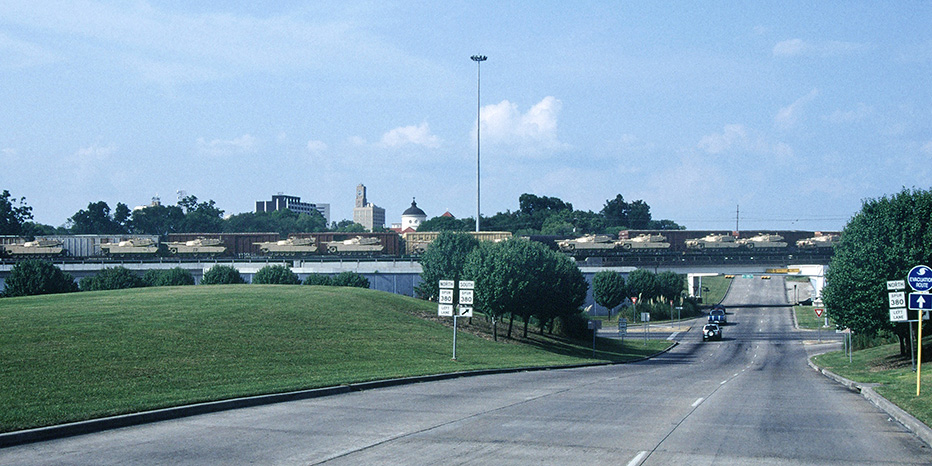
I then had a chance encounter with one of the biggest bullies in foamia (who has since, it seems, mellowed), and then I got this shot at 17:51.
Norfolk Southern? What is that? I had gone a long time without seeing any of that!
This, appropriately, was Kansas City Southern Railway train M-MXJA-15 with Engineer Jim Shaughnessy. So, yes, this train had come from where I had come. “MX” stands for Mexico, and “JA” stands for Jackson, Mississippi.
Even more appropriately, the train was waiting for its southbound counterpart at the Neches River Bridge.
Here is KCS train M-JAMX crossing the Neches River at 18:04 with solid spartan-cab EMD power!
The locomotives were KCS 6610, KCS 649, KCS 607, and TFM 1407. One decade later, the KCS looks very different! For now, for this brief, fleeting moment of time, anti-climactic for what preceded it for the last two months, 1970s EMDs ruled the rails here.
That’s it. Photographically, that is the end of the 2004 Mexico experience.
The Home Stretch
My notebook says that at 19:26 I left Beaumont. I have no idea what I did in the hour after this train passed. Maybe I ate. Maybe I stuck around for more action while the sun was still up. I don’t know. I do know that I arrived back home in bayouland shortly (maybe a half-hour) before midnight that night, forever changed.
Afterwardie
A few days later, I arrived in New Orleans for a week-long We The People teacher workshop which also had the effect of changing my life because the connections that I made there led me to move to the New Orleans area one year later, a dubiously-timed move to the New Orleans area, as described in my “New Orleans Introduces The World” article with picture taken three months and one day earlier. Being there at the workshop in that setting after what I had just experienced was interesting. I got to know parts of New Orleans better, particularly the Riverbend area, saw and chased trains on the New Orleans Public Belt Railroad, and it was my first introduction to Cooter Brown’s. I wanted more of this, and my Close Up experience that January and my Mexico experience that summer made me want to live in an area where I would be exposed to different cultures, ideas, and people; New Orleans, an hour from home, was a logical choice.
Epilogue
Trying to summarize the effects of the entire experience here is futile, but this is a weak-willed attempt; I will eventually write more when I make a compilation page. At the end of 2006, I returned to Mexico for a 10-night visit that ended early in January 2007. I returned again for less than a week in December 2009 and left on 2 January 2010. Two weeks later, the previously safe area around Monterrey erupted in drug war. I had left just in time. Places where I once hung out were now too dangerous even for my Mexican friends to visit. Terrorism had become real.
The Drug War Is Not About Drugs
Seeing the country that I had loved and the safe parts of it that I had called home later get torn and devastated by drug wars was one of several factors that caused my previously naive self to see how much of an awful, destructive, and wrong, even if sometimes well-intentioned war on personal freedom the so-called “War On Drugs” is. When you are born into a world in which consuming a certain substance – even if it harms nobody but yourself – in your own home is considered a “crime,” you somehow assume that the illegality is the default and natural state of things, and you sometimes don’t even consider why a person who uses such substances in his or her own home should be imprisoned. Yes, I was one of those people. That something is “wrong” should be the cause – not the result – of something being illegal. Murder is not wrong because it is illegal; it is illegal because it is wrong, or, specifically, because it has an actual unwilling victim – which makes it wrong. That should be obvious, but it apparently needs to be said.
I simply can no longer defend the practice of incarcerating someone for personal choices. I never could in the first place, but that did not stop me – and it does not stop a great many people today – from attempting to defend the practice (using, always, unwarranted assumptions about people we do not even know) or at least failing to see the wrongness of the practice. That that grossly anti-liberty practice continues into the 21st Century is a great shame. That moralizing is what brought us alcohol prohibition early last century, and those who help maintain similar prohibitions today, even if they don’t realize it, are no better. Indeed, if they endorse the current prohibitions but think that alcohol prohibition was wrong, I cannot help but think that they are hypocrites. Only those few today who would include alcohol (and possibly tobacco) among the list of substances to prohibit outright are not hypocritical. Although I think that they are downright wrong and preachy, at least the full prohibitionist (of all such substances) are not hypocrites, and they have my begrudging respect for being consistent.
The drug war is not really a “war on drugs,” because the drugs don’t go to jail; the people do. People who have not harmed anyone get locked up in cages with murderers, rapists, and thieves, and the convictions make them unable to get good jobs when they get out of prison, needlessly perpetuating the cycle of poverty. The drug war is a civil war; that is why it is only appropriate that fighting has erupted in Mexico, but in the USA we use guns, force, intimidation, and jail too. When the drug war first really erupted in Mexico in early 2010, I at first was upset at my fellow Americans for creating the demand that led to the drug war. Then, I came to realize that the war primarily exists because the drugs are illegal, as we don’t see violence over alcohol trafficking anymore. While it is true that if demand for drugs would go to zero that the drug war would end, not only is that not remotely realistic, but it is drug prohibition that causes the drug war.
If tea became illegal tomorrow, there would eventually be cartels and guns and an underworld associated with tea; would I then blame tea consumers for the violence the way that I had initially blamed drug users for fueling the cartel violence? The murders committed by the drug cartels are the responsibility of those who pulled the triggers, but the prohibitionists have largely created the scenarios for the murders in the first place, meaning that it is the prohibitionist who can end the drug war simply by stopping being prohibitionist (and enacting the legislation that would repeal the legislation that gave us the drug wars.)
Despite what one overly fearful person claimed, I have in no way any “sympathy for drug cartels.” Such a charge is stupid, since ending prohibition would do more than anything to greatly reduce the flow of money to Mexican drug cartels; they are only as powerful as they are because the drugs are illegal, something that is completely artificial. Especially for substances like marijuana, which can be grown in most American back yards or even inside of people’s homes, there is no need – no natural need, anyway – to rely on Mexico as a source. That many Americans sadly associate Mexico with drugs, which is totally unfair to the vast majority of Mexicans, is yet another unfortunate and completely unnecessary result of prohibition.
Of course, this is really about personal choice. I have no use for sugary breakfast cereals or for cigarettes (I hate cigarettes), but if people who used those products in the privacy of their own homes were threatened with jail for the act, I’d be right there defending them too. This is not at all the same thing as banning smoking in public places.
Fortunately, unlike my desire to see flashing green lights in all US traffic lights, there are many more people who are better at organizing and advocating on this issue than I am. We need to end this stupid civil war. If you support it, seriously ask yourself why.
Language And The Mind
Seriously, if the only language that you know is English, you should learn another language. I don’t care how old you are, but if you have young children, you really, really should start them learning a new language early. You really learn plenty about thought itself when learning another language. Unfortunately, I have never been fluent at Spanish, but I have been good enough to hold decent conversations, and I have been good enough at it to realize that we are slaves to language. If you don’t believe me, go ahead and try to think a complex thought without your language.
I came to realize that there were times when, in settings in which I was speaking English to people in the United States, I could not say what I really thought in English as well – as impactful – as I could say it in Spanish. I came to realize that, although we think that thought only dictates language, language does indeed dictate thought.
The Spanish language is, compared to English, set up in such a way that the actor is not as important as either the action or the recipient of the action (if there is one.) For example, in English, we would say:
I sent her flowers.
What is the first thing in the sentence? The identity of the actor is the first thing you see. Before you even know what is happening, you know who did it! The next thing that you know is what is happening (but not totally, since you do not know what is being sent.) The third thing that you know is to whom the action is happening. That same sentence in Spanish would literally read.
Yo le di flores.
However, since subject pronouns are not always used in Spanish simply because the way that Spanish verbs are conjugated indicate who the subject is, that statement would normally be said thus:
Le di flores.
“To her I sent flowers.” The “yo” preceding it would usually only be said if the speaker was trying to put emphasis that it was he (as, possibly, opposed to someone else) who sent her flowers. Otherwise, when someone hears “le di flores,” the first thing heard is who is receiving the action; only after the listener knows who is receiving the action does he or she know what the action is, and only at the end of the verb is there a less-than-one-word clue of who performed the action.
You can imagine the cultural implications that this has! Speakers of Spanish, seemingly no matter the country (though there are variations), tend to be more fatalistic than those in the English-speaking world. In Spanish, stuff happens, whereas in English, someone does something. The reason why Mexicans are generally poorer monetarily than Americans and the reason why they are generally happier than Americans may indeed be the same reason!
In retrospect, I suspect that I came across as self-centered in many of the times I was speaking Spanish to native-speakers of the language because I was trying to speak Spanish as if it was English, emphasizing subjects and actors rather than emphasizing what the actions were and the recipients of those actions. We are all slaves to language, but some of us are enslaved by different languages!
I have said repeatedly – to you and to the high school students to whom I taught Spanish – that learning Spanish made me a better student of English, which means that it has made me a better reader and a better writer. I was forced to look at my own language differently; thus, I learned English a second time, and I am now much better at it. Despite English classes in high school and college, what an infinitive verb is really did not register in my brain until I learned Spanish. Also, because Spanish has two words for “to be,” each with its own meaning and use, the English sentence of . . .
That guy is being a jerk.
is very different – and probably more different than you realize – than the seemingly similar sentence of . . .
That guy is a jerk.
In English, saying the former sentence can get you accused of saying the latter sentence by people who can’t tell the difference, but, in Spanish, since there are separate words for “to be” – ser and estar, the former being of identity and the latter dealing with condition – there would be less confusion in such instances.
A recent article in Business Insider makes the case for learning French, a language that I wish that I knew.
A Kiss Goodbye
I’ll leave you with this, since, as I predicted, these writings have become, while good on their own, incohesive. In Mexico, it is common to greet women with a kiss on the cheek. I had become so accustomed to this, that when I returned to the bayouland high school where I worked at the time before the school years started, I kissed the secretary on the cheek! She didn’t seem to have a problem with this, but she did seem surprised, and then I realized that I had never done this before to her or anyone else at work.
“Never done this before” was kind of the point of the entire experience. I’ll leave you with that, and I won’t kiss you, but I bid you peace.
Thank you for reading and viewing this 2004 summer in Mexico series.
Jimbaux

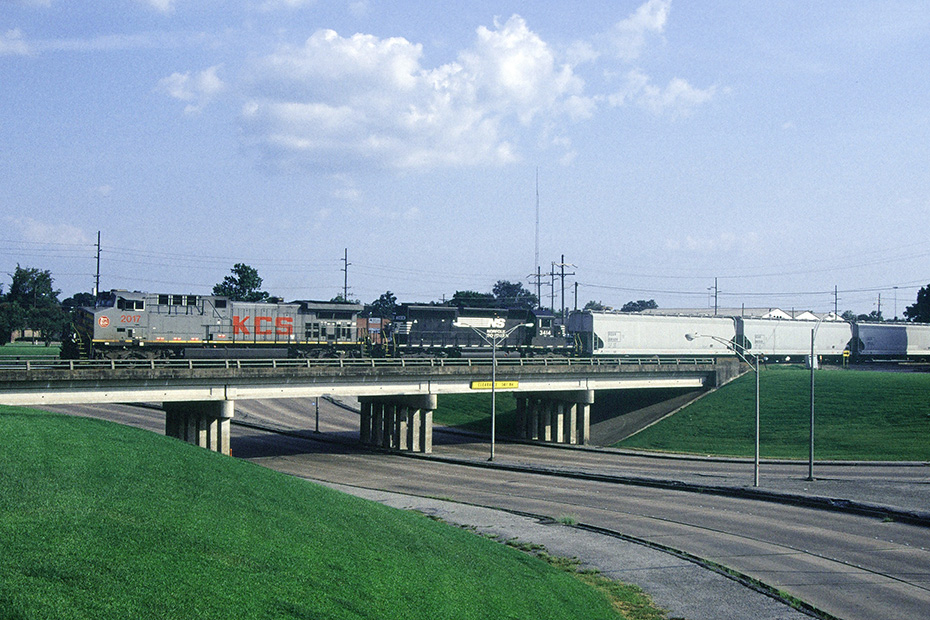

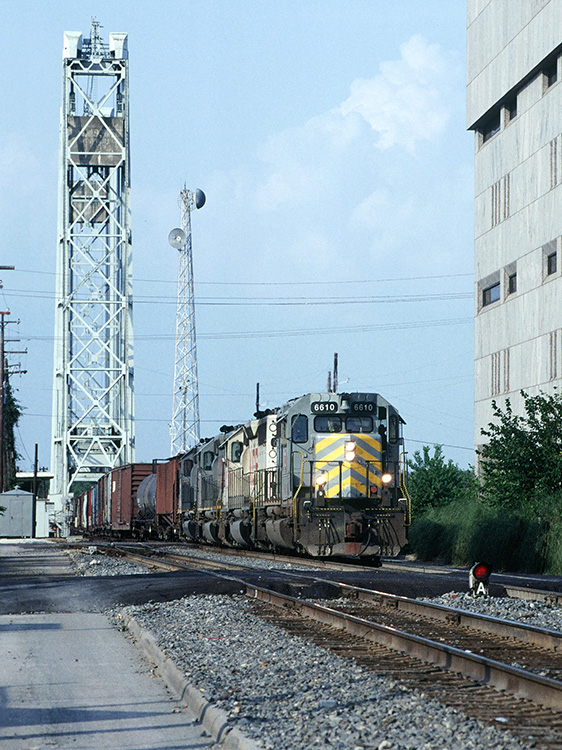
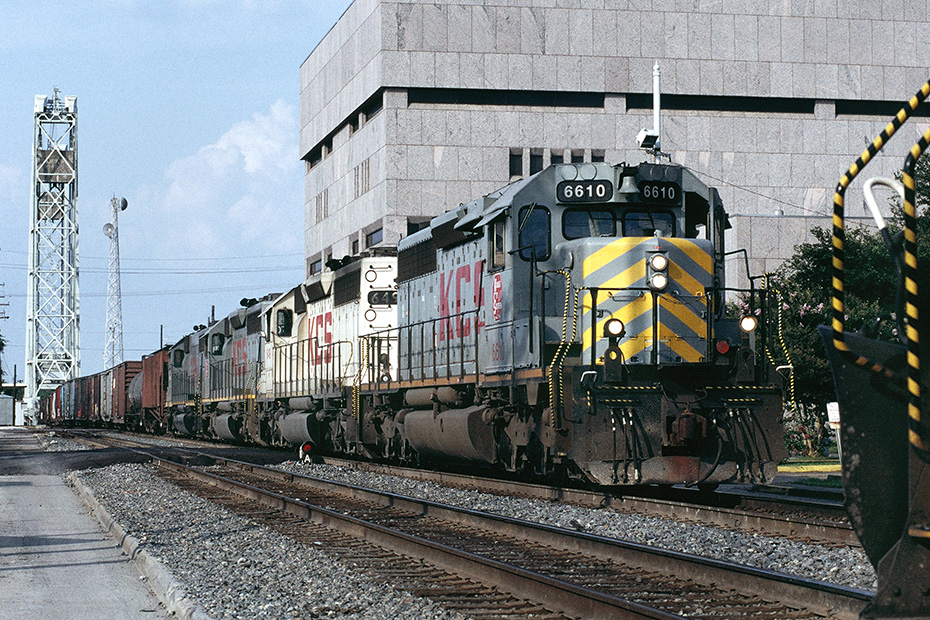

{ 3 comments… read them below or add one }
Thank you, this has been an interesting reading journey, educational and insightful.
Hey man,
thanks for the kiss on the cheek… you point about learning the language, and inevitably, about the culture, is SO true… yet, we Americans will NOT bother… ‘let the world come to us’… (if they come in legally, that is)… and LEARN American English…
Learning French, traveling to France, Greece, Turkey… seeing how other folks have been ‘living and getting along’ for …say, the past 400 years, the past 1000 years, … or Turkey, a 90 year old country with a 6,000 year history behind them…
Life changing… yes it did…
many thanks for your meditations on ‘the meaning of meaning’… and how great it is to travel and see ‘otra veces’…(other places?…I mean.
keep well, Best wishes… will send you a poem about travel, called “Ithaca”…
HNBunte
I think flashing green lights are a great idea. I can see it being beneficial up in northern communities such as here in northern Ontario in the winter, especially. The streets are often covered in snow and ice, despite every effort to clear it, and it’s even more difficult to stop in these conditions. Large vehicles are sometimes forced to go straight through (and often the light turns red in the meantime) because the drivers simply cannot stop in time without sliding and possibly losing control of whatever they’re driving. A flashing green light would be extremely beneficial in these situations. It would be similarly useful when it rains.
You should learn French. C’est une langue très belle.